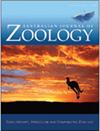Green turtle (Chelonia mydas) hatching success at Raine and Heron Islands
IF 1
4区 生物学
Q3 ZOOLOGY
引用次数: 0
Abstract
ABSTRACT Raine Island, the world’s largest green turtle nesting location, has low nest hatching success. The main causes of this low hatching success are thought to be nest destruction by subsequent nesting females, and inundation of nests during high tides and storm surges. But even nests that are protected from nest destruction and inundation appear to have relatively low hatching success, with most of the embryo mortality occurring early in incubation. Here, I compare hatching success and developmental phase of embryo death of protected ‘dry’ nests from Raine Island (RI) with similar nests from Heron Island (HI), a nesting location previously reported as having high hatching success. Nests at both sites were sampled close to the peak time of nesting (December). Twenty-eight nests were sampled at RI and 14 nests at HI. Nest temperatures were cooler during the first week of incubation at HI (median 26.9°C) than at RI (median 30.1°C), but three-days-in-a-row maximum nest temperatures were higher at HI (median 36.0°C) than at RI (median 33.5°C). I found the hatching success of sampled nests at both locations was similar, ~70%, but most embryo death occurred early in incubation at RI (median 16.5%) compared to HI (median 3.8%), but late in incubation at HI (median 4.9%) compared to RI (median 0.2%).绿海龟(Chelonia mydas)在雷恩和赫伦群岛孵化成功
雷恩岛是世界上最大的绿海龟筑巢地,但其孵化成功率很低。孵化成功率低的主要原因被认为是随后筑巢的雌性破坏了巢穴,以及在涨潮和风暴潮期间淹没了巢穴。但是,即使是那些没有被破坏和淹没的巢穴,孵化成功率也相对较低,大多数胚胎死亡发生在孵化初期。在这里,我比较了Raine岛(RI)受保护的“干”巢的孵化成功率和胚胎死亡的发育阶段与Heron岛(HI)的类似巢的孵化成功率,Heron岛是先前报道的孵化成功率高的筑巢地点。两个地点的巢都是在接近筑巢高峰时间(12月)时取样的。在RI取样28个巢,在HI取样14个巢。孵育第一周,高低温环境(中位数26.9°C)的巢温低于低低温环境(中位数30.1°C),但连续三天的最高巢温在高低温环境(中位数36.0°C)高于低低温环境(中位数33.5°C)。我发现在两个地点取样的巢的孵化成功率相似,约为70%,但大多数胚胎死亡发生在孵育早期(中位数为16.5%)与HI(中位数为3.8%)相比,但在孵育后期(中位数为4.9%)与RI(中位数为0.2%)相比。
本文章由计算机程序翻译,如有差异,请以英文原文为准。
求助全文
约1分钟内获得全文
求助全文
来源期刊
CiteScore
2.40
自引率
0.00%
发文量
12
审稿时长
>12 weeks
期刊介绍:
Australian Journal of Zoology is an international journal publishing contributions on evolutionary, molecular and comparative zoology. The journal focuses on Australasian fauna but also includes high-quality research from any region that has broader practical or theoretical relevance or that demonstrates a conceptual advance to any aspect of zoology. Subject areas include, but are not limited to: anatomy, physiology, molecular biology, genetics, reproductive biology, developmental biology, parasitology, morphology, behaviour, ecology, zoogeography, systematics and evolution.
Australian Journal of Zoology is a valuable resource for professional zoologists, research scientists, resource managers, environmental consultants, students and amateurs interested in any aspect of the scientific study of animals.
Australian Journal of Zoology is published with the endorsement of the Commonwealth Scientific and Industrial Research Organisation (CSIRO) and the Australian Academy of Science.

 求助内容:
求助内容: 应助结果提醒方式:
应助结果提醒方式:


